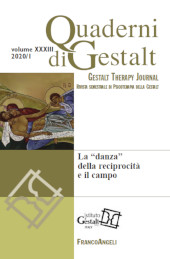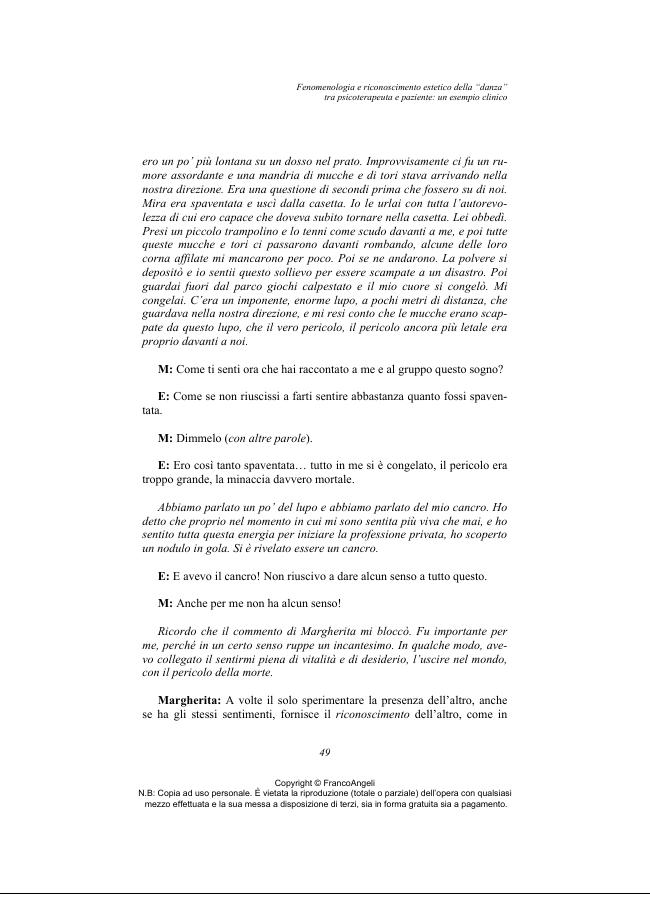Fenomenologia e riconoscimento estetico della "danza" tra psicoterapeuta e paziente : un esempio clinico
41-56 p.
Questo articolo fa seguito alla presentazione dei "passi di danza" tra terapeuta e paziente, pubblicata in un articolo del numero della primavera 2017 del British Gestalt Journal (Spa-gnuolo Lobb, 2017) , e fornisce un esempio clinico di come questo strumento di osservazione fenomenologica ed estetica funziona nella pratica. Inoltre delinea un possibile percorso di ri-cerca. Il presente contributo ha come quadro di riferimento la capacità di risposta (respons-abilità) politica e sociale degli psicoterapeuti nel contesto contemporaneo. Per l'autrice, una principale fonte di sofferenza oggi deriva dalla mancanza di riconoscimento dell'altro, che si evidenzia nella desensibilizzazione corporea dei nostri pazienti.
Questo rende necessario che gli psicoterapeuti della Gestalt si focalizzino sulla reciprocità delle loro interazioni con i pazienti, piuttosto che su come il paziente fa contatto. Infatti, è proprio lì, nella "danza" tra loro, che è presente la possibilità di rivitalizzare il confine di contatto, luogo in cui il sé è co-creato. [Testo dell'editore].
This article follows a first presentation of the "dance steps" between therapist and client, which appeared in the Spring 2017 issue of the British Gestalt Journal (Spagnuolo Lobb, 2017). It gives a clinical example of how this phenomenological and aesthetic observational tool works in practice. The author describes briefly the "dance steps" (described more extensively in the previous paper) and also outlines a possible research path to validate these as a Gestalt therapy observational tool. The aims of the tool will be developed in two directions: (1) A clinical use of the steps for supervision: the supervisor can use the dance steps to supervise the therapeutic situation; (2) Use of the steps for research: a detailed description in behavioral terms of the steps will be provided to describe what happens between two or more people in a therapist/client situation.
Finally, the author presents a clinical case to implement the concept of "dance steps": a phenomenological description of a session reported by the client and by the therapist through a reflection on mutual interactions. The context of the work is a Summer Program that takes place every year at the end of July in Syracuse, Italy: a five-day retreat for psychotherapists from all over the world, with the main aim of taking care of themselves whilst also receiving theoretical and clinical updates. One of the participants describes what she remembered of the session and then the therapist adds her experience. The recollection is live and most of all it recounts the perception of the client and that of the therapist, in "dance steps" terms. It is Gestalt therapy work on a dream, which they have called "the wolf work". The author concludes connecting the use of reciproci-ty to political and social response-ability today.
A main clinical problem today derives from the lack of recognition from the other, which makes bodily desensitization evident in our clients. This brings Gestalt therapists to focus on the reciprocity of their interactions with clients, in-stead of on how only the client makes contact. As a matter of fact, in the actual dance between them there is the possibility of revitalizing the contact boundary, where the self is co-created. [Publisher's text].
-
Articles du même numéro (disponibles individuellement)
-
Informations
Code DOI : 10.3280/GEST2020-001004
ISSN: 2035-6994
KEYWORDS
- Passi di danza tra terapeuta e paziente, fenomenologia, estetica, desensibilizza-zione, reciprocità
- Therapist/client dance steps, phenomenology, aesthetics, desensitisation, reciprocity



